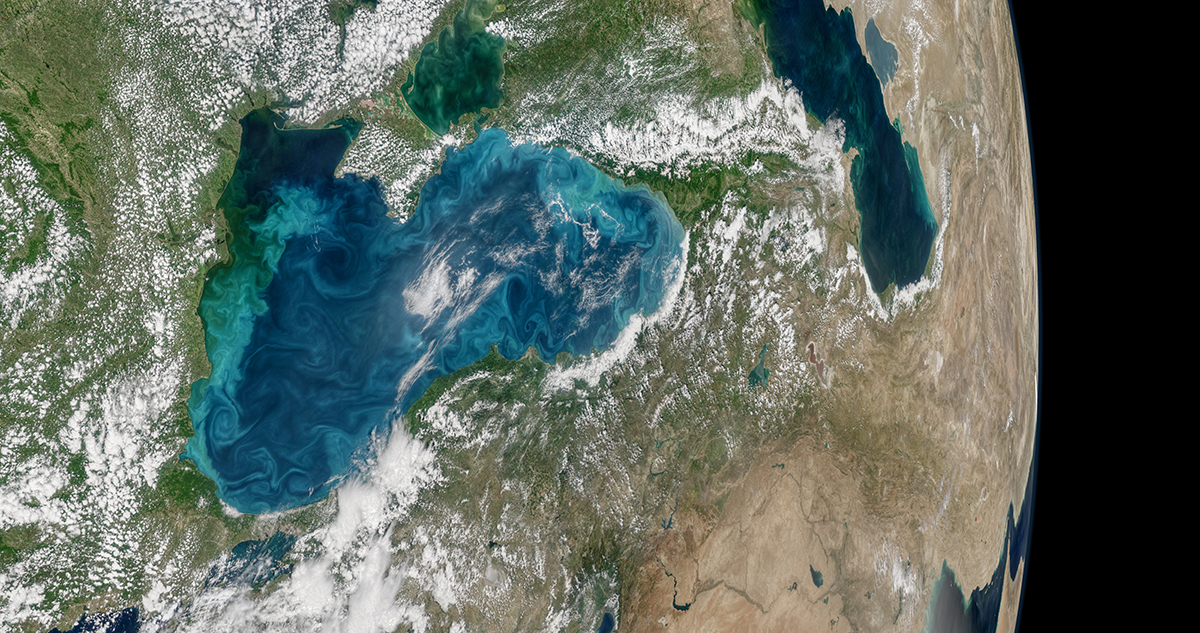
August 26th - Sampling and other wonders
It was one of those perfect sunny days when we sailed from Heraklion on the 14th of August, in our journey to the Black Sea. The sea was calm, the water an unreal blue. Standing on the deck of the RV Pelagia watching rocky islands appear and vanish on the horizon, it was hard not to imagine that we too – like the Greek heroes (Argonauts, Odyssey, or Theseus) from the past – were ready for incredible adventures at sea. Here, a taste of what happened in the days that followed.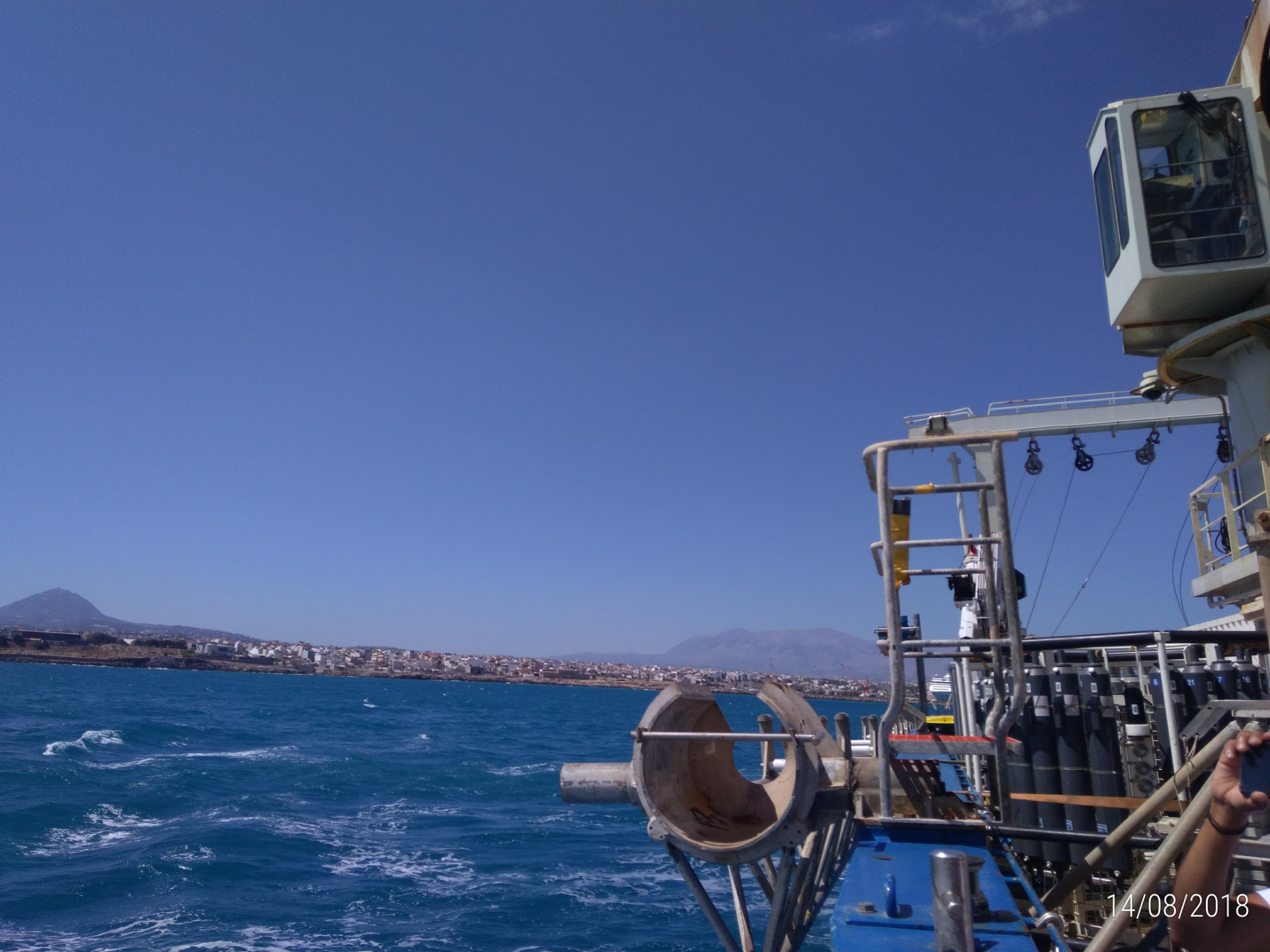
Sampling methane and other wonders
There is much wonder to search for in the depths of the sea. Every layer of the water column, every inch of the sediments will unveil a new type of micro-organism with a colourful new metabolism, or a unique lipid, a niche to be explored, a genome unveiled, an ecosystem understood. Or at least we attempt to do so. Drop by drop. Literally.
When the CTD comes up you will see many scientists getting around with syringes empty and minds filled with the expectation to sample some nutrients like nitrogen species, methane and sulphide. Some others are there with their glass pressure bottles, holding tight, needles in one hand, tubing in the other, waiting for the green light to get some water. A while later, only a few stay behind to fill their big 20L/40L carboys with all the samples they need for their enrichments like DNA, lipids, etc.
Back in the lab people are very busy. All sorts of plastic and glass vials are on the tables, labelled for all the nutrients. Someone is already under the hood adding toxic chemicals or fixing samples. Next to the microscope, a group gathers to witness the magnetotactic bacteria swim towards the magnet. In the containers, people are working in the anaerobic glove bags, protecting samples from the deadly oxygen, adding substrates, or just retrieving filters from the pumps.
Everyone is always busy, and always ready to give a hand. It could not be any other way; cruises are first and foremost a team effort. Everyone gets the opportunity to learn something new, remember something old, and realize that every single thing can and will go wrong. But if you have the will, the patience, and - most importantly - the good company, everything will be fixed and in the end, all of the experiments will be a success.
Stay calm and keep filtering on
The most useful thing for a scientist on board of a ship is to have the ability to make connections. And no, I don’t mean networking, although that is useful in science as well. I refer to the connections you make with tubing, connectors and cable ties. Originally, you may have litres of water that you sampled from the sea. But in the end, you are actually more interested in something like the DNA of the creatures in the water. Or maybe their lipids. Or perhaps, you did something to that water, added some nutrients, or mixed in some magnetic beads, or an antibiotic or two, or a new carbon source, and now you are curious to see what happened to that community you intervened with. Sometimes you may want to give the microbes some more time to react to your ‘interventions’, so all of that water or sediments has to come back to you. To your lab. On land.
But in the frame of the cruise, most samples end up being filtered. And there are many ways to do so. For example, you can lower the always useful in situ pumps and have hundreds of litres of water filtered for you in whatever depth you chose.
However once you have made your experiments on board, you have to use filtration units, tripods and pumps perhaps, to do the job yourself. And although it is a simple task, at least as soon as you figure the logic behind it, it can have its challenges. Sometimes, you use a filter with a very small pore size (0.1μm to give an example), and things get very splashy. The pressure builds up, the water doesn't get filtered and you end up with most of it all over your face. It did happen to me. And not just once.
This said, the biggest challenge is always time. For some, it may take an entire night to filter all their samples. You can ask Ruth all about it. For some, like Pierre, Nina and myself, the task ended a bit earlier, 2 am and something. When you are not alone and waiting for the change of a filter, or to fix an escaping tubing, it can be a place and time for some enlightening conversations, ranging from the philosophy of science to the monsters of man’s imagination that may dwell in the bottom of the Black Sea. Very entertaining if it wasn't for the very, very cold container you are in filtering on.
I do not know of anyone on our scientific party that did not spend hours filtering. And maybe you are thinking, surely this isn't the most exciting activity but, for me at least, that is where all the fun begins. Or maybe I just need more cruises to change my mind about it.
Science after the nightfall
Although most of the work gets done while the sun is still shining up, sometimes, as I already implied before, you have to stay up till later, because science never sleeps. Even when the scientists really, really want to get some rest. When the sun is gone and the last CTD just hits the de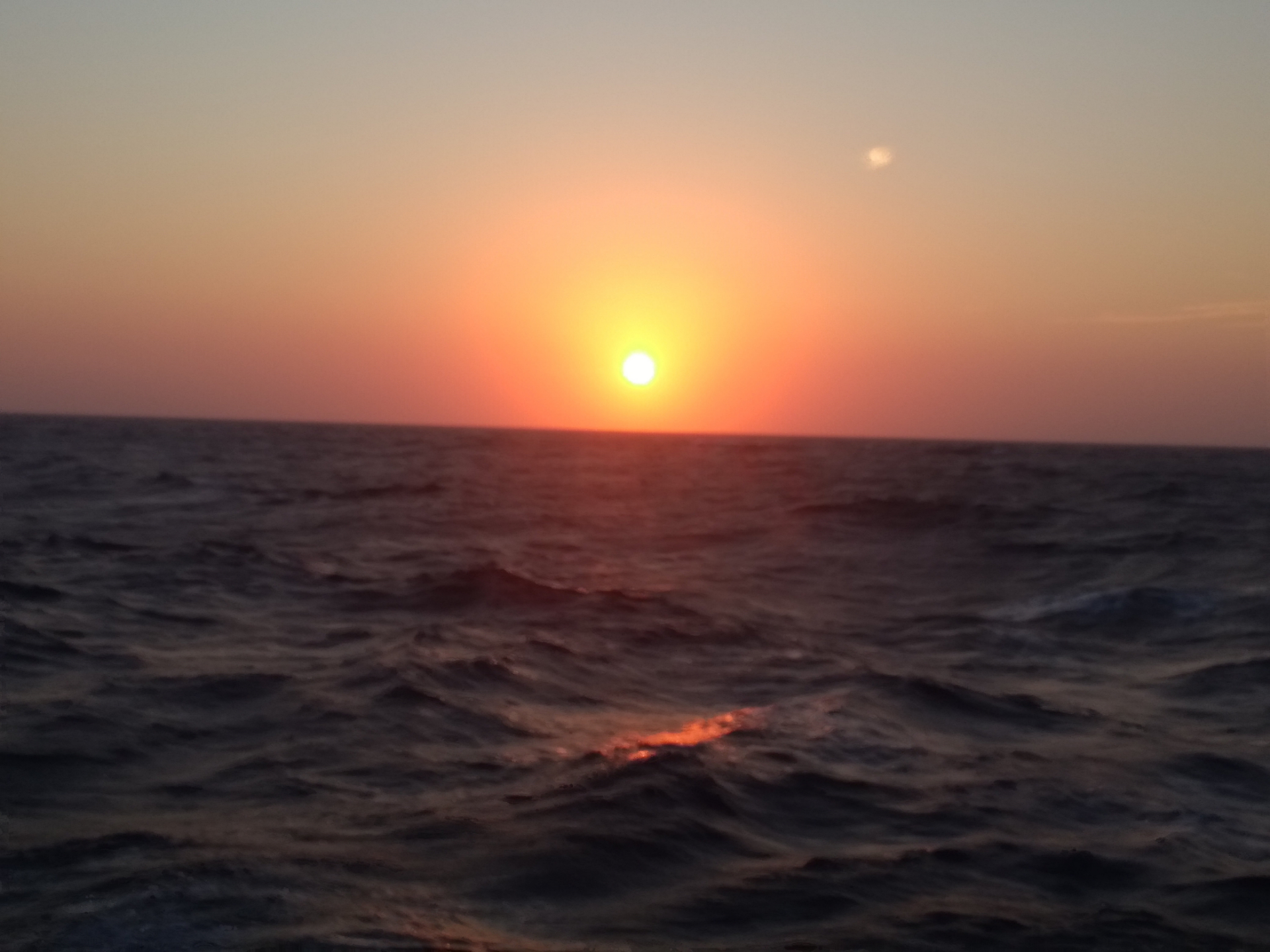 ck you can see the tired faces getting ready for another round. Believe it or not, that is when all the fun happens. You can witness some very nice singing (or that is what Peter and I chose to believe about our artistic abilities), the silliest jokes and even one attempt for a scary story, involving a scientist, sampling and the sea. After that round we did not want any more scary stories. You also hear the most inspiring speeches, the most contagious laughter, and the incredible stories of hallucinations with moving floors from someone who hasn't yet overcome completely their first days seasickness (that would be me again, but the wooden floor really looked like moving!). In the end people are always trying to keep everyone spirits up. It is after all, and I will never get tired of saying it, teamwork. None stays behind, none is left alone. And that for me is the most beautiful thing about this cruise. That it is a first and foremost, human experience.
ck you can see the tired faces getting ready for another round. Believe it or not, that is when all the fun happens. You can witness some very nice singing (or that is what Peter and I chose to believe about our artistic abilities), the silliest jokes and even one attempt for a scary story, involving a scientist, sampling and the sea. After that round we did not want any more scary stories. You also hear the most inspiring speeches, the most contagious laughter, and the incredible stories of hallucinations with moving floors from someone who hasn't yet overcome completely their first days seasickness (that would be me again, but the wooden floor really looked like moving!). In the end people are always trying to keep everyone spirits up. It is after all, and I will never get tired of saying it, teamwork. None stays behind, none is left alone. And that for me is the most beautiful thing about this cruise. That it is a first and foremost, human experience.
Of course, most of the nights are much more fun. You may experience some very, very competitive dart tournament. Or a very friendly, not at all competitive Rummi-Q match. Or swimming in the pool. Yes, a pool. But I don't know if I would call sitting in a small children pond – swimming. But lets keep the illusion alive. Or you can just stay watching the sea, listening to the wind, following the moon and the stars. And if you are really lucky, maybe even seeing some dolphins, like we did, when we passed the Bosphorus, on our way to the station.
The thing is, you never get bored on a ship like the RV Pelagia, even if all that is around you is the sea, and your vessel is small, you are guaranteed to spend an amazing time.
Now, on the last day of our trip, most of the scientific party is already on their way back home, and the few of us left are waiting for the Cyprus authorities to let us ashore. A new party arrives, and a new story is about to begin. The new destination is the Red Sea and from there, on and on.
Leaving the Pelagia always feels a little bit as a break up. For some it is as heart breaking as saying goodbye to a place that felt like home. A bubble being cruelly burst. It is a life you will only understand once you have been wobbling in the corridors, being rocked asleep or waken by the waves, eating till you can’t breath, sharp at 12.30 and then at 18.00 again, with multiple candy bars and soft drinks in between, and staring at the infinite horizon where the water meets the sky.
For now all it is left so say is, to the Pelagia and its wonderful, brave and funny crew: fair winds and a calm sea, and till the next adventure.
Dina Castillo Boukhchtaber, PhD candidate, NIOZ\Utrecht University
August 21th - The Black Sea is a very good environment for creatures who do not "breathe on oxygen"
Let me first introduce myself! I am Subhash Yadav from India, working at Royal
NIOZ Sea Research. I have been already participated in different sampling tours in India and South Korea. So I was bit familiar with sampling tours. But in contrast to my previous experiences, the current expedition is really exciting! Especially the R/V Pelagia which is well equipped with mobile laboratory where we can efficiently perform microbiological experiments like anaerobic inoculation, incubations and microscopic analysis. In addition, it is well equipped with instruments for in-situ observation like CARD-FISH. It also have very high quality sampling instruments and nice crew members.
The weather is quite pleasant; beautiful sunny days, little wind but sea is almost calm. Seawater looks very clean and quite blue. In free times, I used to watch sea and several islands coming on our way. Its really good to watch and listen to the voice of the sea on the moving Pelagia. Nice weather, friendly crew members and passionate researchers are just amazing! Our group is highly diverse which is focusing on different aspects of anaerobic microbiology. We belong to different countries which makes it very international.
On the way to our Black sea expedition, I first landed to Heraklion, Greece on August, 13th where I had chance to see the Crete city. It was really exciting to see the shopping complex and general store names written by Greek alphabets like alpha, beta, gamma, delta, psi, phi, epsilon etc. We left Heraklion on August, 14th for Black sea expedition.
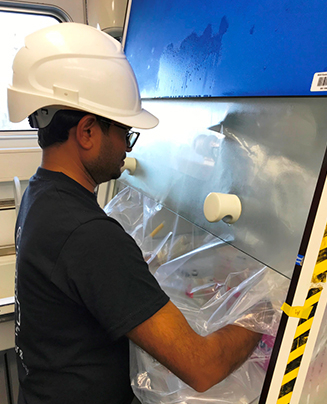 We reached to Black sea on August 17th and started collecting water samples from different depths as much as possible. Black sea water colour is bit different from what we saw at Heraklion. It is greyish to somewhat blue in colour. I am on board Pelagia to cultivate a candidate bacterial phyla (Cloacimonetes) which is quite abundant in deep water column (2000 m). Although, they are in good abundance in black sea but they behave as highly sophisticated creatures when we try to grow them in our lab. Genome analysis of this group of bacteria indicates that they might be involved in polysaccharide degradation and interestingly may have sulfate reducing activity too. For growing these group of bacteria, I have already prepared growth media made up of different carbon sources like cellobiose, lysine, histidine, proline, culture extracts etc. I hope they will like these nutrients and will be happy to propagate in our lab. I am also trying to provide them very homely environment in our lab where they can interact with their neighbours and share the nutrients for their growth. Finally, we have collected several litres of sea water from different depth (1000, 1500 and 2000m). I have also observed collected water samples under microscope where I am able to see different tiny living creatures which appears to be very happy. "Black" sea was named due to its inhospitable nature. But our microscopic observation indicates that black sea is very good (not “BLACK”) environment for creatures which do not "breathe on oxygen".
We reached to Black sea on August 17th and started collecting water samples from different depths as much as possible. Black sea water colour is bit different from what we saw at Heraklion. It is greyish to somewhat blue in colour. I am on board Pelagia to cultivate a candidate bacterial phyla (Cloacimonetes) which is quite abundant in deep water column (2000 m). Although, they are in good abundance in black sea but they behave as highly sophisticated creatures when we try to grow them in our lab. Genome analysis of this group of bacteria indicates that they might be involved in polysaccharide degradation and interestingly may have sulfate reducing activity too. For growing these group of bacteria, I have already prepared growth media made up of different carbon sources like cellobiose, lysine, histidine, proline, culture extracts etc. I hope they will like these nutrients and will be happy to propagate in our lab. I am also trying to provide them very homely environment in our lab where they can interact with their neighbours and share the nutrients for their growth. Finally, we have collected several litres of sea water from different depth (1000, 1500 and 2000m). I have also observed collected water samples under microscope where I am able to see different tiny living creatures which appears to be very happy. "Black" sea was named due to its inhospitable nature. But our microscopic observation indicates that black sea is very good (not “BLACK”) environment for creatures which do not "breathe on oxygen".
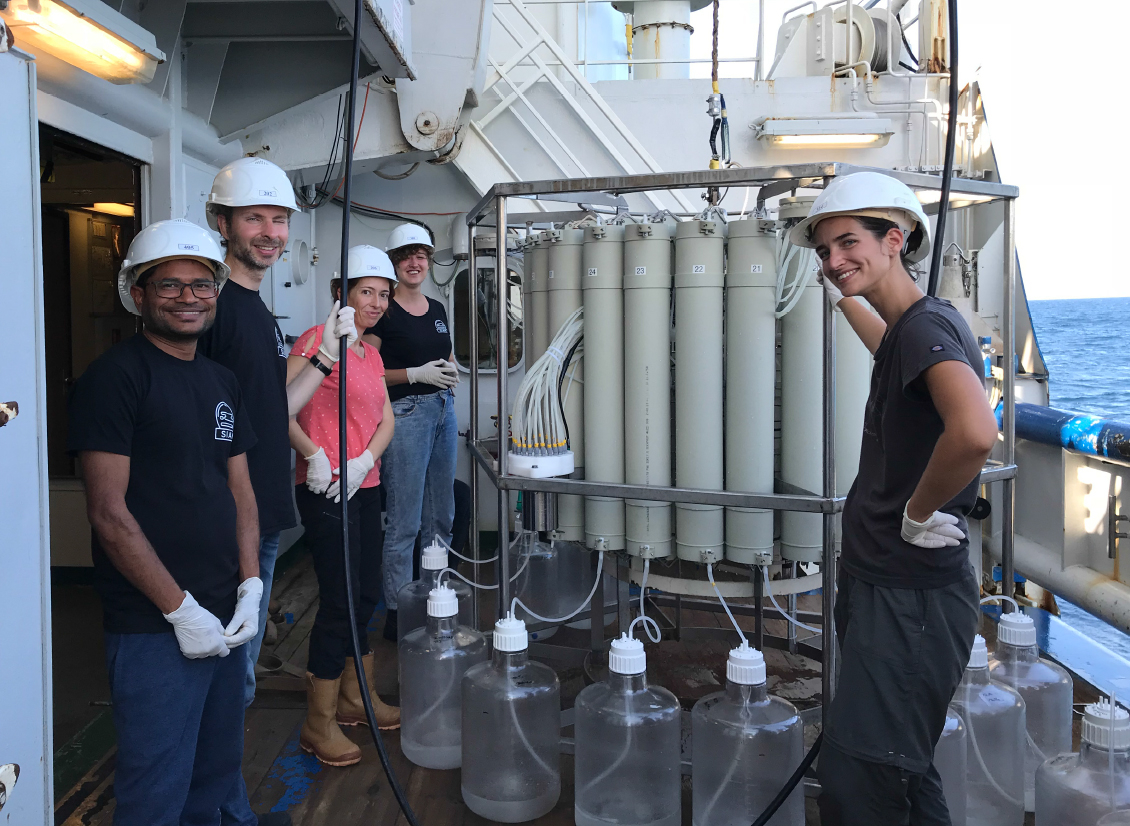
August 17th - On our way to the Black Sea
This is the first blog for the NIOZ/SIAM Black Sea Cruise, or as we call it on the ship: 64PE444. We embarked three days ago on R/V Pelagia from the Heraklion seaport on Crete with one goal in mind: to research the wonderful world of the microbiology of the Black Sea.
As I am writing this, we are waiting to cross the Bosporus strait, with a grand view of Istanbul to accompany us until the port authorities give us permission to pass. This does not mean we are idle! The ship is littered with pumps, filters, chemicals and bottles of all shapes and sizes that have to be ordered, placed inside our mobile laboratories and prepared for the many experiments we are planning to perform once we’ve reached the research station. So far, the trip has been wonderful, with great, sunny weather and calm seas which has given us plenty of opportunities to test out our equipment in the labs. The crew has been very helpful to get us scientists acquainted with the ship and the cook has been spoiling us with amazing food so we feel more than prepared to carry out our scientific tasks.
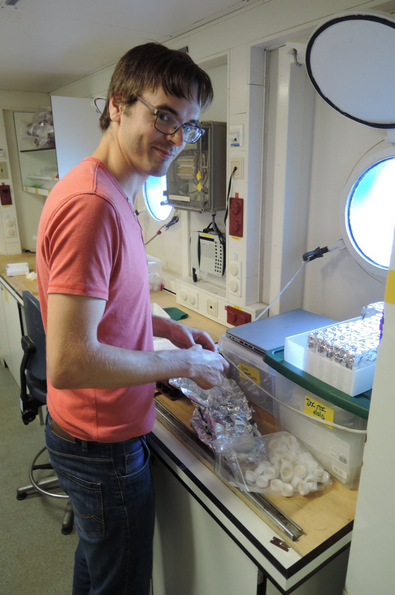 Bacteria in de sediment layer, 2000 meter below sea level
Bacteria in de sediment layer, 2000 meter below sea level
As a SIAM scientist, I am interested in the bacteria that thrive in the absence of oxygen in the sediment layer, 2000 meters below sea level. The stratified nature of this sediment makes the Black Sea a unique environment to look for novel metabolisms and identify the microbes capable of performing them. With the help of a piston core, an 18 meters long metal tube that will be plunged into the depths of the sea, I will collect sediment samples that will be sampled for DNA to see which organisms are able to live in this extreme environment. I will also use these sediment samples to enrich for bacteria capable of degrading specific compounds so we can study them in detail back home.
With 10 scientists from all disciplines on board, there’s a lot of science talk during our daily after-dinner discussions where everyone has to present their research. This way, we know why everyone’s on board and we can help them out immediately if their experiments needs an extra pair of hands or two. I’m very excited for the next few days of sampling and our way back to Limasol on Cyprus where we can start our experiments and find out what surprises the Black Sea has in store for us.
Peter Fisher, PhD-candidate, Wageningen Marine Research